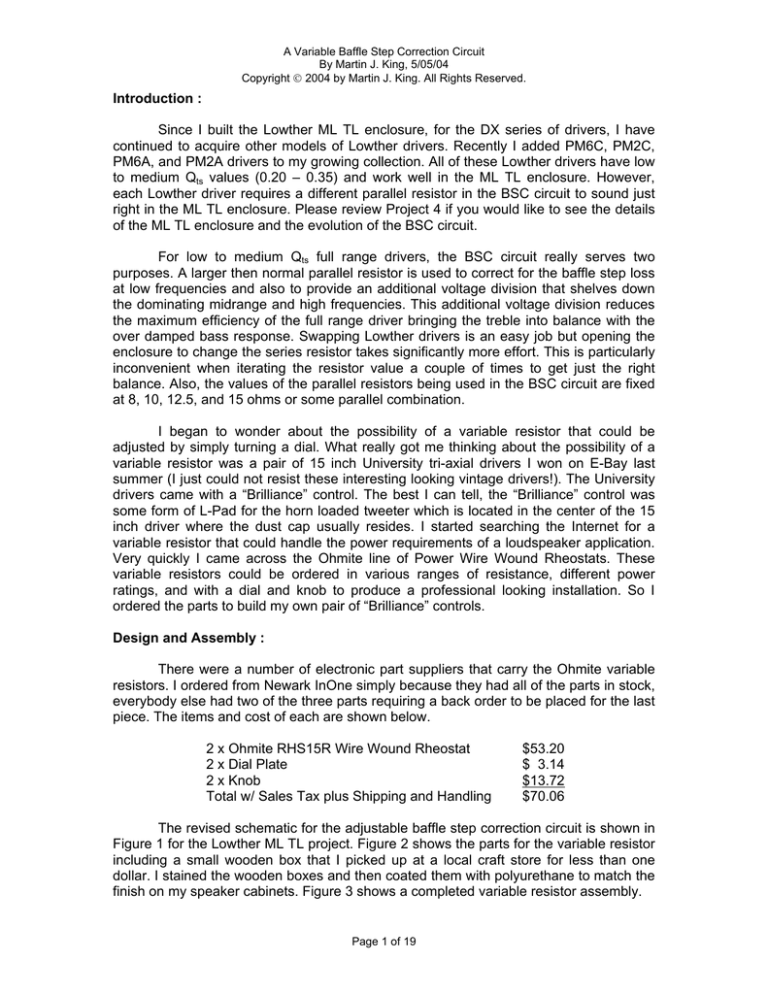
A Variable Baffle Step Correction Circuit
By Martin J. King, 5/05/04
Copyright 2004 by Martin J. King. All Rights Reserved.
Introduction :
Since I built the Lowther ML TL enclosure, for the DX series of drivers, I have
continued to acquire other models of Lowther drivers. Recently I added PM6C, PM2C,
PM6A, and PM2A drivers to my growing collection. All of these Lowther drivers have low
to medium Qts values (0.20 – 0.35) and work well in the ML TL enclosure. However,
each Lowther driver requires a different parallel resistor in the BSC circuit to sound just
right in the ML TL enclosure. Please review Project 4 if you would like to see the details
of the ML TL enclosure and the evolution of the BSC circuit.
For low to medium Qts full range drivers, the BSC circuit really serves two
purposes. A larger then normal parallel resistor is used to correct for the baffle step loss
at low frequencies and also to provide an additional voltage division that shelves down
the dominating midrange and high frequencies. This additional voltage division reduces
the maximum efficiency of the full range driver bringing the treble into balance with the
over damped bass response. Swapping Lowther drivers is an easy job but opening the
enclosure to change the series resistor takes significantly more effort. This is particularly
inconvenient when iterating the resistor value a couple of times to get just the right
balance. Also, the values of the parallel resistors being used in the BSC circuit are fixed
at 8, 10, 12.5, and 15 ohms or some parallel combination.
I began to wonder about the possibility of a variable resistor that could be
adjusted by simply turning a dial. What really got me thinking about the possibility of a
variable resistor was a pair of 15 inch University tri-axial drivers I won on E-Bay last
summer (I just could not resist these interesting looking vintage drivers!). The University
drivers came with a “Brilliance” control. The best I can tell, the “Brilliance” control was
some form of L-Pad for the horn loaded tweeter which is located in the center of the 15
inch driver where the dust cap usually resides. I started searching the Internet for a
variable resistor that could handle the power requirements of a loudspeaker application.
Very quickly I came across the Ohmite line of Power Wire Wound Rheostats. These
variable resistors could be ordered in various ranges of resistance, different power
ratings, and with a dial and knob to produce a professional looking installation. So I
ordered the parts to build my own pair of “Brilliance” controls.
Design and Assembly :
There were a number of electronic part suppliers that carry the Ohmite variable
resistors. I ordered from Newark InOne simply because they had all of the parts in stock,
everybody else had two of the three parts requiring a back order to be placed for the last
piece. The items and cost of each are shown below.
2 x Ohmite RHS15R Wire Wound Rheostat
2 x Dial Plate
2 x Knob
Total w/ Sales Tax plus Shipping and Handling
$53.20
$ 3.14
$13.72
$70.06
The revised schematic for the adjustable baffle step correction circuit is shown in
Figure 1 for the Lowther ML TL project. Figure 2 shows the parts for the variable resistor
including a small wooden box that I picked up at a local craft store for less than one
dollar. I stained the wooden boxes and then coated them with polyurethane to match the
finish on my speaker cabinets. Figure 3 shows a completed variable resistor assembly.
Page 1 of 19
A Variable Baffle Step Correction Circuit
By Martin J. King, 5/05/04
Copyright 2004 by Martin J. King. All Rights Reserved.
One thing that concerned me was the presence of any inductance that might be
inherent in the wire wound resistor. I connected one of the finished assemblies to LAUD
and measured the impedance as a function of frequency at different dial positions. The
LAUD impedance plots are included as Attachment 1. A summary table of the resistance
as a function of dial position is provided below in Table 1. The Ohmite variable resistor
behaved just like a fixed value Mills resistor over the frequency range 20 Hz to 20 kHz.
Table 1 : Resistance as a Function of Dial Value
Dial Value Resistance (ohms)
0
0.4
10
1.0
20
2.3
30
3.8
40
5.3
50
6.8
60
8.5
70
10.1
80
11.5
90
12.9
100
14.4
Installation :
I installed the variable resistors into the BSC circuit by threading the leads
through the port and attaching them to the appropriate points on the circuit board
mounted inside the ML TL enclosure. I left enough wire to be able to place the small
boxes beside the speakers so adjustments to the resistance could be made quickly.
Figure 4 shows the details of the connection and placement of the variable resistor while
Figure 5 shows the complete speaker system with the Lowther PM2C drivers installed.
Performance :
I have tried the variable resistor with several different Lowther drivers and found
it really works well. You can change the Lowther driver and set the knob to zero
essentially removing the BSC circuit from the speaker system. Then by rotating the knob
clockwise progressively add more parallel resistance until you reach an optimum value
for your room, amp, Lowther driver model, and personal taste. This is a quick and easy
adjustment that can be made in approximately 0.1 ohm steps. You can really hear the
influence of the circuit and the improvement in the system’s overall balance when just
the right resistance value is found.
Conclusion :
The “Brilliance” control described above makes achieving an optimum BSC
circuit parallel resistance as simple as twisting a dial. While there is no single answer for
every speaker system and installation, this arrangement should accommodate most of
the possibilities. There are many Ohmite Power Wire Wound Rheostats available with
different resistance ranges and higher power ratings for more demanding applications.
Page 2 of 19
A Variable Baffle Step Correction Circuit
By Martin J. King, 5/05/04
Copyright 2004 by Martin J. King. All Rights Reserved.
If you are using a Lowther driver, or some other low Qts full range driver, in the
ML TL enclosure then this particular variable resistor can be adjusted in the range 8 to
12 ohms for a solid state amp with a high damping factor or 2 to 8 ohms for a low
powered tube amp with a low damping factor. The Lowther ML TL enclosure design, with
a variable BSC circuit, is not limited to just one type of amp. A simple twist of a knob can
open this design to anybody interested in building a low Qts full range speaker system
independent of the type of amplifier being used.
Page 3 of 19
A Variable Baffle Step Correction Circuit
By Martin J. King, 5/05/04
Copyright 2004 by Martin J. King. All Rights Reserved.
Figure 1 : Variable BSC Circuit Schematic for Lowther Drivers in the ML TL Enclosure
Ohmite 0 - 15 ohm 25 Watt Resistor
ERSE 3.0 mH
+
Solen 2.0 µF
eg
-
Page 4 of 19
Mills
15 Ω
+
Solen
3.0 µF
-
Lowther Driver
A Variable Baffle Step Correction Circuit
By Martin J. King, 5/05/04
Copyright 2004 by Martin J. King. All Rights Reserved.
Figure 2 : Variable Resistor Parts
Page 5 of 19
A Variable Baffle Step Correction Circuit
By Martin J. King, 5/05/04
Copyright 2004 by Martin J. King. All Rights Reserved.
Figure 3 : Assembled Variable Resistor
Page 6 of 19
A Variable Baffle Step Correction Circuit
By Martin J. King, 5/05/04
Copyright 2004 by Martin J. King. All Rights Reserved.
Figure 4 : Installed Variable Resistor
Page 7 of 19
A Variable Baffle Step Correction Circuit
By Martin J. King, 5/05/04
Copyright 2004 by Martin J. King. All Rights Reserved.
Figure 5 : Lowther PM2C Speaker System with Variable BSC Circuit
Page 8 of 19
A Variable Baffle Step Correction Circuit
By Martin J. King, 5/05/04
Copyright 2004 by Martin J. King. All Rights Reserved.
Attachment 1 : Impedance Plots of the Variable Resistor as a Function of Dial Position
and Frequency
Page 9 of 19
A Variable Baffle Step Correction Circuit
By Martin J. King, 5/05/04
Copyright 2004 by Martin J. King. All Rights Reserved.
Page 10 of 19
A Variable Baffle Step Correction Circuit
By Martin J. King, 5/05/04
Copyright 2004 by Martin J. King. All Rights Reserved.
Page 11 of 19
A Variable Baffle Step Correction Circuit
By Martin J. King, 5/05/04
Copyright 2004 by Martin J. King. All Rights Reserved.
Page 12 of 19
A Variable Baffle Step Correction Circuit
By Martin J. King, 5/05/04
Copyright 2004 by Martin J. King. All Rights Reserved.
Page 13 of 19
A Variable Baffle Step Correction Circuit
By Martin J. King, 5/05/04
Copyright 2004 by Martin J. King. All Rights Reserved.
Page 14 of 19
A Variable Baffle Step Correction Circuit
By Martin J. King, 5/05/04
Copyright 2004 by Martin J. King. All Rights Reserved.
Page 15 of 19
A Variable Baffle Step Correction Circuit
By Martin J. King, 5/05/04
Copyright 2004 by Martin J. King. All Rights Reserved.
Page 16 of 19
A Variable Baffle Step Correction Circuit
By Martin J. King, 5/05/04
Copyright 2004 by Martin J. King. All Rights Reserved.
Page 17 of 19
A Variable Baffle Step Correction Circuit
By Martin J. King, 5/05/04
Copyright 2004 by Martin J. King. All Rights Reserved.
Page 18 of 19
A Variable Baffle Step Correction Circuit
By Martin J. King, 5/05/04
Copyright 2004 by Martin J. King. All Rights Reserved.
Page 19 of 19


